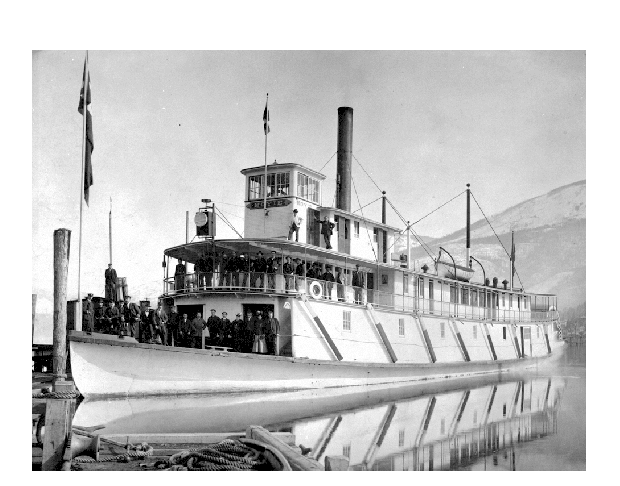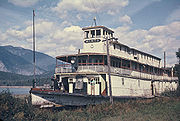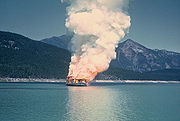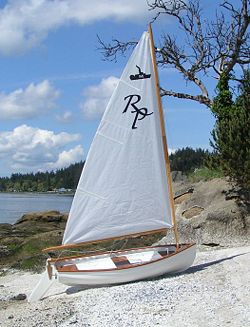.gif)
Minto (sternwheeler)
Encyclopedia
- This article is about a lake steamer in British Columbia. For other uses, see Minto (disambiguation)
Minto was a sternwheel steamboat that ran on the Arrow Lakes
Arrow Lakes
The Arrow Lakes in British Columbia, Canada, divided into Upper Arrow Lake and Lower Arrow Lake, are widenings of the Columbia River. The lakes are situated between the Selkirk Mountains to the east and the Monashee Mountains to the west. Beachland is fairly rare, and is interspersed with rocky...
in British Columbia
British Columbia
British Columbia is the westernmost of Canada's provinces and is known for its natural beauty, as reflected in its Latin motto, Splendor sine occasu . Its name was chosen by Queen Victoria in 1858...
from 1898 to 1954. In those years of service, Minto had steamed over 2 million miles serving the small communities on Arrow Lakes. Minto and her sister Moyie
Moyie (sternwheeler)
The Moyie is a paddle steamer sternwheeler that worked on Kootenay Lake in British Columbia, Canada from 1898 until 1957.After her nearly sixty years of service, she was sold to the town of Kaslo and restored...
(which ran on Kootenay Lake
Kootenay Lake
Kootenay Lake is a lake located in British Columbia, Canada and is part of theKootenay River. The lake has been raised by the Corra Linn Dam and has a dike system at the southern end, which, along with industry in the 1950s-70s, has changed the ecosystem in and around the water...
) were the last sternwheelers to run in regularly scheduled passenger service in the Pacific Northwest. The "Minto" class
Minto Sailing Dinghy
The Minto Sailing Dinghy is a sailing dinghy first produced commercially in the early 1960 and still in production.-Initial version:The Minto Sailing Dinghy began its life as a skiff for a 24 foot sloop built by Hugh Rodd at Canoe Cove on Vancouver Island...
of sailing dinghies
Dinghy
A dinghy is a type of small boat, often carried or towed for use as a ship's boat by a larger vessel. It is a loanword from either Bengali or Urdu. The term can also refer to small racing yachts or recreational open sailing boats. Utility dinghies are usually rowboats or have an outboard motor,...
is named after this vessel.
Manufactured for the Stikine River service

Stikine River
The Stikine River is a river, historically also the Stickeen River, approximately 610 km long, in northwestern British Columbia in Canada and southeastern Alaska in the United States...
during the Klondike gold rush
Klondike Gold Rush
The Klondike Gold Rush, also called the Yukon Gold Rush, the Alaska Gold Rush and the Last Great Gold Rush, was an attempt by an estimated 100,000 people to travel to the Klondike region the Yukon in north-western Canada between 1897 and 1899 in the hope of successfully prospecting for gold...
. The other vessels were Moyie and Tyrrell.The Canadian Pacific Railway which commissioned the vessels had hoped to develop an "All-Canada" route to the Yukon gold fields that bypassed the other routes, generally through Skagway
Skagway, Alaska
Skagway is a first-class borough in Alaska, on the Alaska Panhandle. It was formerly a city first incorporated in 1900 that was re-incorporated as a borough on June 25, 2007. As of the 2000 census, the population of the city was 862...
, Dyea
Dyea, Alaska
Dyea is a former town in the U.S. state of Alaska. A few people live on individual small homesteads in the valley; however, it is largely abandoned. It is located at the convergence of the Taiya River and Taiya Inlet on the south side of the Chilkoot Pass within the limits of the Municipality of...
, or from St. Michael
St. Michael, Alaska
St. Michael is a city in Nome Census Area, Alaska, United States. At the 2000 census the population was 368.-Geography:St. Michael is located at on the east side of St...
on the Bering Sea
Bering Sea
The Bering Sea is a marginal sea of the Pacific Ocean. It comprises a deep water basin, which then rises through a narrow slope into the shallower water above the continental shelves....
all the way up the long Yukon River
Yukon River
The Yukon River is a major watercourse of northwestern North America. The source of the river is located in British Columbia, Canada. The next portion lies in, and gives its name to Yukon Territory. The lower half of the river lies in the U.S. state of Alaska. The river is long and empties into...
. All the parts for these steamers were manufactured in Toronto, Ontario and shipped to the west coast of Canada for assembly.
Reassigned to Arrow Lakes
When the Stikine Route to the Klondike proved to be a failure in the first three months of its opening in 1898, the C.P.R. was left with a number of steamers, including Minto (then in a disassembled state) that it needed to find routes for. C.P.R. decided to assemble Tyrrell in Vancouver, Moyie on Kootenay LakeKootenay Lake
Kootenay Lake is a lake located in British Columbia, Canada and is part of theKootenay River. The lake has been raised by the Corra Linn Dam and has a dike system at the southern end, which, along with industry in the 1950s-70s, has changed the ecosystem in and around the water...
, and Minto at the Bulger shipyard on upper Arrow Lake at Nakusp. Minto was needed on the Arrow Lakes because the C.P.R.'s big new steamer Nakusp
Nakusp (sternwheeler)
The Nakusp was a sternwheel steamboat that operated from 1895 to 1897 on the Arrow Lakes of British Columbia.-Design and construction:Nakusp was commissioned by the Columbia and Kootenay Steam Navigation Company to replace the sternwheeler Columbia which had burned in 1894. Capt. James W...
had been destroyed by fire in 1897. It is possible that some preliminary assembly work was done on Moyie and Minto in Vancouver before they were shipped inland still in pieces. The construction program for the Stikine River service, and the eventually assembly of Minto and her sisters, was supervised by the veteran steamboat captain James W. Troup
James W. Troup (steamboat captain)
James William Troup was an American steamship captain, Canadian Pacific Railway administrator and shipping pioneer.-Family:...
, the superintendent of C.P.R.'s Lake and River service. C.P.R. decided to assemble Moyie first, and her composite steel and wood hull was riveted together first at Nelson, BC. The assembly crew then moved over to Nakusp on upper Arrow Lake and on and then on July 26, 1898, began work on the Minto. Reportedly there were literally 1,000 pieces for each sternwheeler.
Durable hull design
The hulls of Minto, Moyie and Tyrrell hull were built on steel frames, with a wood bottom and steel sheets on the side. This gave Minto some ability to handle ice conditions on the lake, better than the wooden-hulled Nakusp, thus allowing operations to continue later into the year, but even so it was the custom to push an ice-breaking barge ahead of her in wintry conditions where ice could be encountered. In addition, the composite hulls gave these vessels a much greater working life than all the other boats on both the Arrow Lakes and Kootenay Lakes. Wooden hulls quickly became waterlogged and lost their strength; Minto and Moyie did not have this weakness.Service on Arrow Lakes
When Minto was complete, C.P.R. had a total of five sternwheelers on Arrow Lakes, which besides Minto were the new express passenger lake boat RosslandRossland (sternwheeler)
The Rossland was a sternwheel steamboat that ran on the Arrow Lakes in British Columbia. It was named after Rossland, British Columbia, once a prosperous mining town in the region.-Design and construction:...
, the new boat Kootenay and the older Trail and Lytton
Lytton (sternwheeler)
Lytton was a sternwheel steamboat that ran on the Arrow Lakes and the Columbia River in southeastern British Columbia and northeastern Washington from 1890 to 1904.-Design and construction:...
, and two steam tugs. Minto with her steel-sided hull, generally ran in the winter months, while the wooden-hulled Rossland and Kootenay ran more in the summer, when tourist traffic was greater and their vulnerable hulls were not threatened by ice.
Additional cabins constructed
While Minto and Moyie were almost identical as built (Moyie was just slightly larger at 835 tons against the 829 of Minto), over the years there came to be more substantial differences, such as additional cabin space being added to Minto added in the winter off-season of 1909-1910. These involved extended the "texas" which the name for the cabin placed on the topmost or "hurricane" or "texas" deck. Similar work was done the year before on the Rossland and the Kootenay and images of all vessels can be roughly dated by comparison of the length of the Texas on each boat. In Mintos case, the additional cabins cost $2,953 to construct.Winter operations
Winter months imposed sharp restrictions on steamboat operations on the Arrow Lakes. Minto was the best of the fleet for dealing with these conditions, which could result in ice 10 inches thick across the entire upper lake. In some winters, Minto was unable to travel to lower Arrow Lake, and C.P.R. used the steam propeller passenger and tug boat Columbia to take her place.In the very cold winter of 1916, Kootenay became icebound at the southern end of the Narrows between upper and lower Arrow Lakes. Minto with her steel-sided hull, was sent down from Nakusp to take her passengers (fortunately there were not many). Minto could not reach Koontenay but was able to get close enough so the passengers could walk over the ice or on shore to get to Minto. Kootenay was eventually able to work free, but her hull was permanently damaged.
Effect of the Great War
_loading_troops_ca_1915.jpg)
Decline of the steamers
By 1923, there were only two sternwheelers running on the Arrow Lakes, the very large BonningtonSS Bonnington
Bonnington was a sternwheel steamboat that ran on the Arrow Lakes in British Columbia from 1911 to 1931. Bonnington and two sisterships were the largest sternwheelers ever built in British Columbia...
and the Minto. No more were built after 1914, although C.P.R. did effect renovations to Minto, adding 20 new staterooms in 1920 and replacing her boiler in 1929.
The Great Depression
Great Depression
The Great Depression was a severe worldwide economic depression in the decade preceding World War II. The timing of the Great Depression varied across nations, but in most countries it started in about 1929 and lasted until the late 1930s or early 1940s...
and changing travel patterns hit the Arrow Lakes hard. After the summer season of 1931, Bonnington was taken out of service and moored at Nakusp, and would never run again. This left only Minto and the tug Columbia running operations on the Arrow Lakes. During the summer, Minto made the complete run through the lakes from Arrowhead to Robson and back. During the winter, Minto worked on the upper lake, and Columbia served on the lower one.
Survival to the 1950s
Both Minto and Moyie survived for a long time. She had a good crew who kept her in good condition, and some were long-term veterans on board. Walter Wright was her captain in the 1940s, and he had started out as a watchman on Mintos first voyage in 1898. While Minto and Moyie continued to function as genuine transportation links, they also became famous as a form of living history. People who loved steamboats came from all over North America to ride on them. The Saturday Evening Post published an article about Minto and the National Film Board made a motion picture about her. In 1947, summing up their later careers, Professor Mills wrote of Minto and Moyie:By 1954, of all the steamboats that had run in British Columbia, and all of Alaska and the Pacific Northwest, only two remained in regular passenger service, Moyie and Minto. The C.P.R. was losing $100,000 every year on its Arrow Lakes service, and the docks at Nakusp and Robson needed upgrading, which would have cost an additional $16,000. Minto herself would have needed an expenditure of $10,000 to pass her next inspection.
Last run
On April 24, 1954, Minto made her last run on the Arrow Lakes. By then, Minto had steamed an estimated 2.5 million miles during her service life. That morning Minto left the dock at West Robson, BC on lower Arrow Lake, with flags and bunting flying, Captain Bob Manning in command and 150 passengers on board. All the staterooms were sold out. People came from all over British Columbia and beyond to ride with the Minto. One honored passenger was Mrs. Olivia Maitland, who had been on board the Minto fifty-six years before on the steamer's first voyage. Other officers were Reg Barlow, second engineer, his son Fred Barlow, first officer, Lawrence Exton, and Jack Edmonds, purser.Departing from Robson, Minto stopped for the last time at all the small landings on the lake that she had always served. At Syringa Creek the retired postmaster, who had served for 50 years, handed over the mail one last time, then stood on the dock with his hat in his hand as the steamer pulled away. At Edgewood a crowd sang Auld Lang Syne
Auld Lang Syne
"Auld Lang Syne" is a Scots poem written by Robert Burns in 1788 and set to the tune of a traditional folk song . It is well known in many countries, especially in the English-speaking world; its traditional use being to celebrate the start of the New Year at the stroke of midnight...
while across the lake at Fullmore Point Jock Ford played a mournful song on the bagpipes. Captain Manning stopped the engines briefly so passengers could hear the pipes. At Burton
Burton, British Columbia
Burton is a settlement on the Arrow Lakes in the West Kootenay region of southeastern British Columbia, Canada.Before european contact, Burton was known as xaieken , a large village of Sinixt first nations people. Burton came to be in the 1890's when gold was found at Cariboo Creek, a steamboat...
the citizens placed a large cedar wreath on her bow. At Arrowhead
Arrowhead, British Columbia
Arrowhead is a former steamboat port and town at the head of Upper Arrow Lake in British Columbia, Canada. Though the initial site has been submerged beneath the waters of the lake, which is now part of the reservoir formed by Hugh Keenleyside Dam at Castlegar, the name continues in use as a...
, farmer John Nelson had posted an enormous sign that read "Let us honor the brave pioneers of navigation on the scenic Arrow Lakes by making it possible to continue the very efficient services of the S.S. Minto. Similar scenes occurred on other places along the route until Minto came back to Nakusp for the last time.
Attempts at preservation fail

Final destruction

Keenleyside Dam
Hugh Keenleyside Dam is a hydroelectric dam spanning the Columbia River, 12 km upstream of the city of Castlegar, British Columbia, Canada....
was being built that would rise 170 feet, and when complete, would raise all the lake levels, drowning the Narrows between the upper and lower Arrow Lakes, and submerging all the landings and many of the towns along the shore under water as much as 40 feet deep. BC Hydro
BC Hydro
The BC Hydro and Power Authority is a Canadian electric utility in the province of British Columbia generally known simply as BC Hydro. It is the main electric distributor, serving 1.8 million customers in most areas, with the exception of the Kootenay region, where FortisBC, a subsidiary of Fortis...
which was building the dam, offered to move and restore Minto, but only if someone else paid the cost which was estimated at $100,000. John Nelson's son Walter didn't have the money and Mintos deteriorated condition after over ten years out of service did not seem to warrant any further effort to preserve here. On August 1, 1968, she was towed out into the lake to be deliberately burned. Walter Nelson, son of her last owner, lit the match to set fire the boat, and in a few minutes the vessel's upper works were consumed in the flames. The hull was later sunk.
Sailing dinghy class Minto

Minto Sailing Dinghy
The Minto Sailing Dinghy is a sailing dinghy first produced commercially in the early 1960 and still in production.-Initial version:The Minto Sailing Dinghy began its life as a skiff for a 24 foot sloop built by Hugh Rodd at Canoe Cove on Vancouver Island...
of sailing dinghies
Dinghy
A dinghy is a type of small boat, often carried or towed for use as a ship's boat by a larger vessel. It is a loanword from either Bengali or Urdu. The term can also refer to small racing yachts or recreational open sailing boats. Utility dinghies are usually rowboats or have an outboard motor,...
, which were built in the 1950s and 1960s. The shape of these small boats was supposedly inspired by a lifeboat carried on board the steamer Minto, and to memorialize this, the class symbol shown on the sail is a sternwheel steamboat.
Further reading
- Faber, Jim, Steamer's Wake -- Voyaging down the old marine highways of Puget Sound, British Columbia, and the Columbia River, Enetai Press, Seattle, WA 1985 ISBN 0-9615811-0-7
- Timmen, Fritz, Blow for the Landing -- A Hundred Years of Steam Navigation on the Waters of the West, Caxton Printers, Caldwell, Idaho ISBN 0-87004-221-1
Photographs of Minto from the Provincial Archives of British Columbia
- Minto under way This is probably from sometime later than 1920, after additional cabins had been added to Minto. The image well shows the spray kicked up by the sternwheel as the vessel was underway. (Identification as this image as circa 1890 by the Provincial Archive is an error.)
- Minto and tug Beaton, at Arrowhead, August 1944 This is a good view of Minto in her later years. The close proximity of the rail line to the steamboat docket is apparent from the passenger cars visible to the left of the vessel.
- Minto burning at Galena Bay, August 1, 1968
Websites
- BC Hydro website on Minto Contains many good color photographs of Minto in her later years and also of her destruction in 1968 (accessed 2008-04-11)

